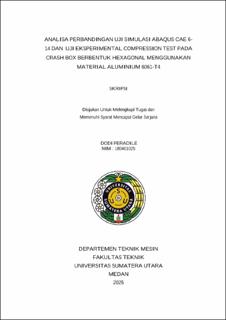| dc.contributor.advisor | Nasution, Fadly Ahmad Kurniawan | |
| dc.contributor.author | Peradile, Dodi | |
| dc.date.accessioned | 2025-02-10T09:13:33Z | |
| dc.date.available | 2025-02-10T09:13:33Z | |
| dc.date.issued | 2025 | |
| dc.identifier.uri | https://repositori.usu.ac.id/handle/123456789/101056 | |
| dc.description.abstract | The rapid development of the industrialized world, automobile safety and impact-
resistant performance have attracted increasing attention to vehicle design. One of
them is Crash box. The crash box has a function as an absorber that is able to channel
the kinetic energy formed in the vehicle during a collision. The durability of the
aluminum crash box material helps protect other important components in the
vehicle and helps keep passengers safe. The overall design of the crash box and the
use of other materials also play a role in determining the performance and safety of
the vehicle in a crash situation. In addition, applicable safety standards and
regulations must also be considered to ensure compliance and optimal protection.
This research aims to analyze experimental crash box testing using compression
tests with a hexagonal-shaped crash box manufacturing process with variations of
one hole, two holes, and three holes, to predict crash box performance. While the
experimental test results have the aim to validate and test the effectiveness of crash
boxes with variations of triger holes in energy absorption in collision events. Then,
analyze the simulation results of error presentation using abaqus CAE software and
experimental compression test with variation of hexagonal triger hole model. The
test used a universal compression testing machine. Based on the analysis of the
simulation study of the crash box model with a variety of holes, the more the number
of holes in the crash box, the smaller the energy that can be absorbed. The result of
the one-hole crash box can absorb 697 joules of energy when compared to the two
hole crash box model which only absorbs 674 joules of energy and the three-hole
crash box model which can absorb 659 joules of energy. This comparison shows that
the energy absorption trend decreases as the number of trigger holes increases. The
results of the analysis on the compressive test study of the one-hole crash box model
which can absorb energy of 730 joules when compared to the two- hole crash box
model which only absorbs energy of 639 joules and the three-hole crash box model
which can absorb energy of 608 joules. The results of abaqus cae 6-14 simulation
tests and experimental compression tests obtained the percentage value of errors in
each crash box model of one hole model of 4.5%, two holes of 5.4% and three holes
of 7.7%. In conclusion, the comparison of crash box models with hole variations
results in decreased energy absorption as the number of trigger holes in the crash
box increases and there are several sources that need to be improved in experimental
and simulation methods to obtain more accurate results. | en_US |
| dc.language.iso | id | en_US |
| dc.publisher | Universitas Sumatera Utara | en_US |
| dc.subject | crash box | en_US |
| dc.subject | uji experimental compression test | en_US |
| dc.subject | uji simulasi abaqus cae 6-14 | en_US |
| dc.subject | experimental compression test | en_US |
| dc.subject | simulation test abaqus | en_US |
| dc.title | Analisa Perbandingan Uji Simulasi Abaqus Cae 6-14 dan Uji Eksperimental Compression Test pada Crash Box Berbentuk Hexagonal Menggunakan Material Aluminium 6061-T4 | en_US |
| dc.title.alternative | Comparative Analysis of Abaqus Cae 6-14 Simulation Test and Experimental Compression Test on Hexagonal Crash Box Using Aluminum 6061-T4 Material | en_US |
| dc.type | Thesis | en_US |
| dc.identifier.nim | NIM180401025 | |
| dc.identifier.nidn | NIDN0112088603 | |
| dc.identifier.kodeprodi | KODEPRODI21201#Teknik Mesin | |
| dc.description.pages | 85 Pages | en_US |
| dc.description.type | Skripsi Sarjana | en_US |
| dc.subject.sdgs | SDGs 9. Industry Innovation And Infrastructure | en_US |


